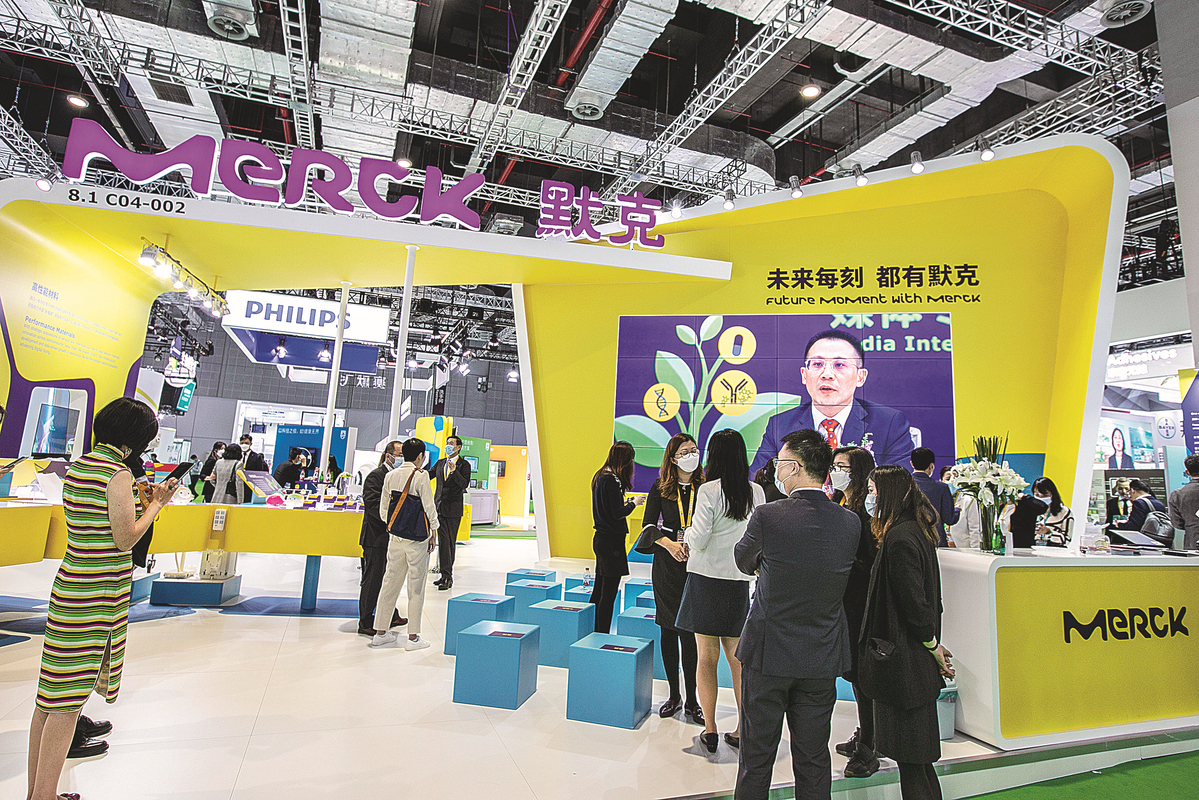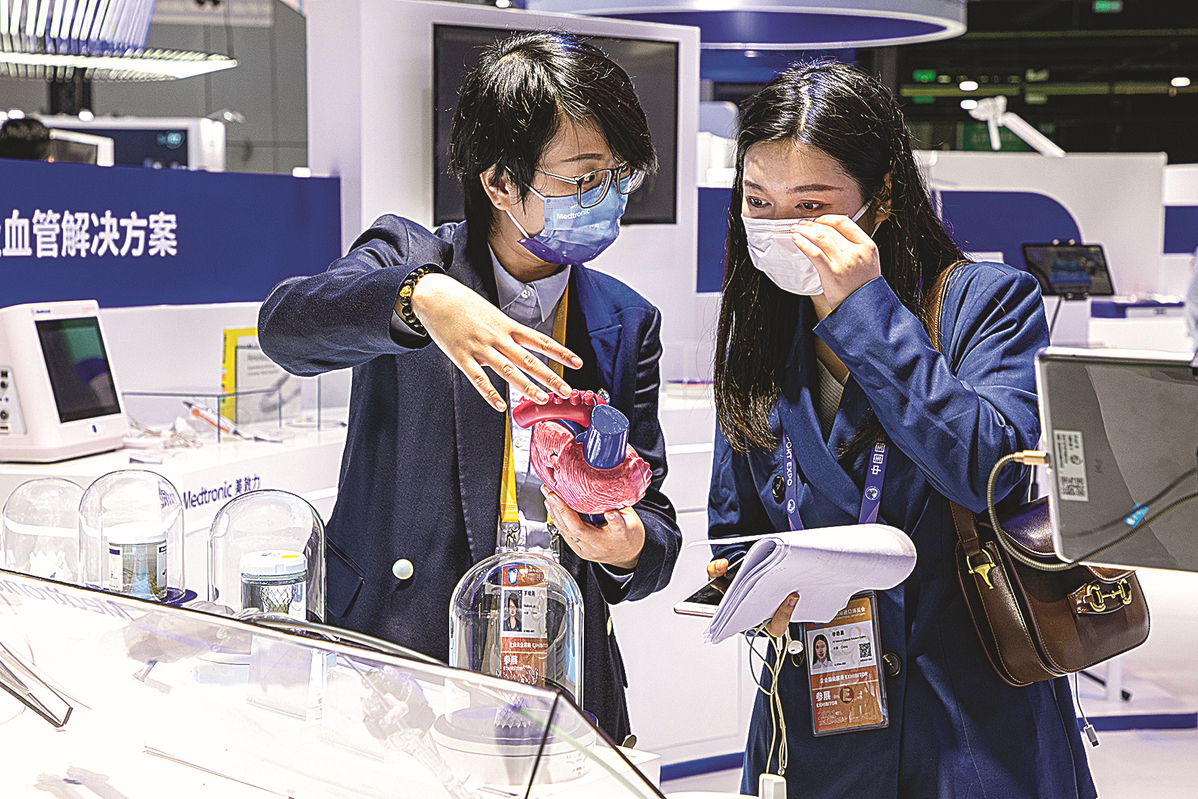MNCs plug into open innovation initiatives

Visitors gather at Merck's booth during an expo in Shanghai. [Photo/China Daily]
Medtronic, Merck, Covestro tell the world why China is a leading global sci-tech hot spot
Multinational corporations in China are accelerating open innovation initiatives with local authorities and partners in a bid to exploit new business opportunities relevant to local markets.
For instance, global medical technology provider Medtronic co-organized a digital healthcare solution competition earlier this month with the Shanghai Technology Innovation Center, its latest endeavor in joint innovation in the Chinese market.
Eight startups made it to the competition's final, where each presented end-to-end medical plans that bank on digital solutions throughout the diagnosis, treatment and recovery process.
"Digital health in China should have a great future," said Noah Friedman, vice-president of strategy, business intelligence and digital market development at Medtronic China. "A contest would be a nice way to see a wide range of technologies and where this is going."
The cohort of the finalist companies mainly had a spinal or cardiac business focus, areas that are aligned with the strength of Medtronic. Friedman said he is "surprised" to see many already have a product-based model, and a majority of them already have a to-business model.
According to Friedman, the products showcased in the competition do have a significant digital component. And it then becomes critical to integrate the high amount of potential data with the product and lead it to clinical outcomes.
"The goal is to understand what is happening in digital-related medical technology," he said. "And it's great... companies have clinical data that allow us to see problems and real clinical success."
Medtronic has made a series of moves to strengthen local partnerships worldwide through open innovation initiatives. Just last year in China, the company launched its second Medtronic Innovation Center in Chengdu, capital of Sichuan province.
Part of Medtronic's global open innovation network, the Chengdu center is bigger than its peer in Shanghai and aims to share high-quality resources, and expedite the transformation of cutting-edge medical technologies into clinical outcomes.

Visitors check out medical products at Medtronic's booth-during the fourth China International Import Expo in Shanghai in November. [Photo/China Daily]
German chemical giant Covestro is embracing the Group Open Innovation initiative of the government of Shanghai's Pudong New Area, which is also home to the company's Asia-Pacific headquarters.
The GOI plan, currently enrolling 34 technologically advanced companies, encourages industry leaders like Covestro to set up open innovation platforms and calls for deeper integration among government services, industries, universities and research institutes.
It has also established a post-doctoral station at its Polymer Research and Development Center, the R&D hub for Asia-Pacific.
These open innovation projects stand on a slew of stellar figures Covestro registered in China, its largest single market.
Sales in the country jumped 57.5 percent year-on-year to 3.54 billion euros ($3.9 billion) in 2021, which outpaced an already robust 48.5 percent growth for the group and occupied 22 percent of the global pie, according to Holly Lei, senior vice-president of Covestro and president of Covestro China.
Volume for core businesses also surged 14.3 percent (versus 10 percent globally). Total investment in China amounted to over 3.8 billion euros by the end of last year.
To make itself more resilient in, and relevant to, the local market, Covestro has built up a track record of forging strong ties with partners, as represented by its partnership with Tongji University on new energy cars and sustainable materials. Their partnership is more than a decade old.
Similarly, it recently signed a memorandum of understanding with the Shanghai Institute of Organic Chemistry, which is part of the Chinese Academy of Sciences.
Companies that have a strong foothold in local ties tend to deliver a strong China balance sheet, experts said.
Proof of that came from the latest earnings from science and technology conglomerate Merck, which showed that the Asia-Pacific region contributed around 36 percent to its revenue. The region is "driven by China to a great extent", said Belen Garijo, chair of the executive board and CEO of Merck.
"The commitment and the level of investment in China span across the three sectors," Garijo said in a conference call to reporters in March, citing examples such as the M Lab Collaboration Center in Shanghai that serves its life science customers in China.
The facility, the embodiment of open innovation, encourages new drug development and offers customized solutions from services to training.
In October, Merck opened its Shanghai Innovation Base located in the Pudong New Area, marking the establishment of the company's first innovation collaboration site open to startups in China.
Besides the core areas of Merck in healthcare, life sciences and electronics, the Shanghai Innovation Base will focus on innovative startups and partner with them in strategic growth fields like AI-enabled health solutions, bioelectronics and cultured meat (lab-grown meat produced from animal cells), as well as early-stage exploration in the fields of neuromorphic systems and organoids.
"China is one of the leading global innovation hot spots. The scale of investment, the support from the government and the dynamic of the startups make the ecosystem a center for the next potential breakthroughs," said Laura Matz, Merck's chief science and technology officer.
- GLOBALink | Volkswagen Group confident in Chinese market: executives
- GLOBALink | Investing in China brings opportunities for prominent European companies
- Interview: GE Aerospace more committed to China after spin-off, says regional head
- Australian winemaker looks to go deep into Chinese market
- Xinhua Headlines: Multinationals ready to embrace new opportunities in Chinese market

